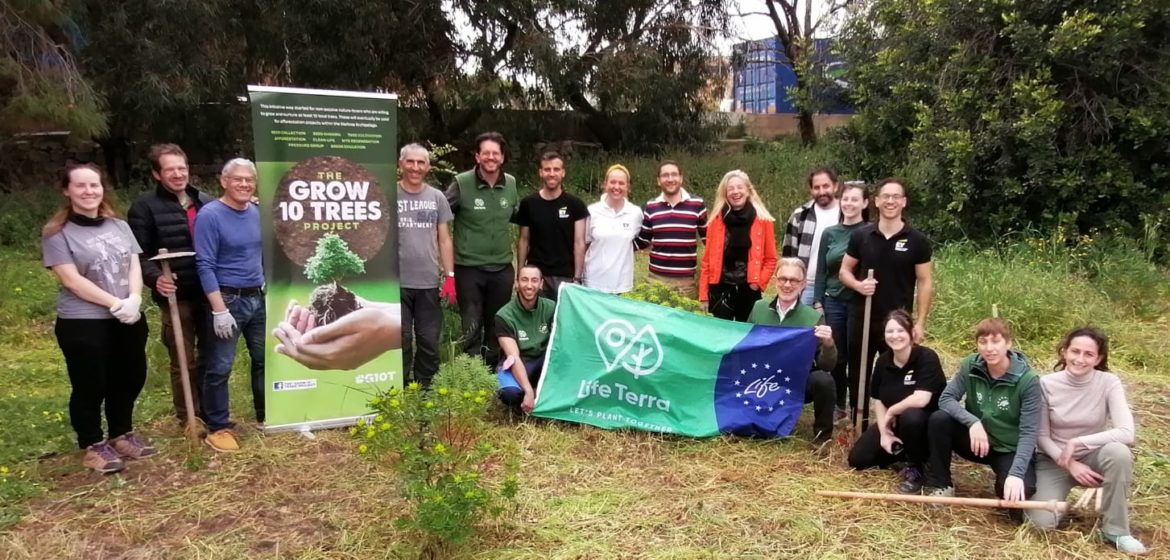
tree planting in Malta with Grow10Trees and Life Terra
The International Union for Conservation of Nature (IUCN) defines nature-based solutions as “actions to protect, sustainably manage, and restore natural or modified ecosystems that address societal challenges effectively and adaptively, simultaneously providing human well-being and biodiversity benefits.”
The European Commission defines nature-based solutions to societal challenges as “solutions that are inspired and supported by nature, which are cost-effective, simultaneously provide environmental, social and economic benefits and help build resilience”.
The difference is that IUCN stresses the need for biodiversity benefits, while the European Commission talks about more general environmental, social and economic benefits. They are very similar, and the key is that we can work with nature to reach sustainable development goals.
Nature-based solutions (NbS) originate from the premise that there is no trade-off between nature conservation and socio-economic development, and that we can maintain, and arguably improve ecosystem services, or even improve them. Ecosystem services are the many and varied benefits to humans provided by the natural environment. In simple terms, you can say that without ecosystem services there is no life possible.
NbS for carbon reduction
There are many ways in which we can help to mitigate climate change through working with nature, and most of this is based on the fact that living plants use photo-synthesis to survive. Photosynthesis is the binding of CO2 and water to create sugars that are the basis for natural growth and oxygen.
Tree planting
One of the best known examples of working with nature to absorb existing CO2 in the atmosphere is the planting of trees. There is quite a lot of discussion in social media about the benefits and the draw backs of tree planting, and I have received messages about the negative aspects of afforestation.
First, a fundamental statement: cutting natural trees to plant new trees is criminal, and clearing natural forests to create new plantations should be a legal offence. We need to use all our efforts to protect old growth forests, and to especially keep the remaining tropical rain forests intact. Maintaining natural forests is critical for a number of reasons, as old growth forests provide many services to mankind. These so-called ecosystem services include food and fodder, firewood and shelter, water and soil protection, refuges for endangered plants and animals, as well as critical carbon sequestration values.
But, the human population has already denuded large swathes of land, and erosion is taking hold in areas that used to be productive land. According to the UN Convention to Combat Desertification (UNCCD), land degradation is one of the world’s most pressing environmental problems. They estimate that 1 in 5 hectares is now considered degraded, and that the carbon that is lost from erosion and degradation accounts for almost a quarter of all global greenhouse gas emissions. Planting trees on barren land, and therefore creating additional carbon sinks, is a positive action in the fight against climate change. I am proud to be a member of the expert panel of the Life Terra Foundation. We are planting trees throughout Europe!
When trees are burned, the opposite takes place, and CO2 is released into the atmosphere. Deliberate burning of forests in the Amazon Basin, Central Africa and Southeast Asia is unnecessarily adding to the greenhouse gas emission, and should urgently be stopped through political will and better enforcement of laws and regulations. One of the main outcomes of the 2021 Glasgow climate meeting, COP26, was an agreement to stop logging forests. The countries who have signed the pledge – including Brazil, Canada, China, the Democratic Republic of the Congo, Indonesia, Russia and the United States – cover around 85% of the world’s forests. I can only hope that this agreement will result in real forest protection.
Unfortunately, climate change itself is causing weather patterns that encourage forest fires in areas of the world that were less vulnerable in the past, as we are more regularly experiencing in Australia, western North America and southern Europe. These feedback loops are what concerns climate scientists so much, as they are unpredictable and they can un-do achievements of previous years, and add future vulnerability. But we can still work with nature to minimize the impact, and having proper fire prevention and management plans in place can help. Artificial Intelligence can help to identify areas most at risk, and proper fire management corridors will slow down the growth of the fire.
Bamboo planting
One of the criticisms of planting trees to sequester carbon is the fact that it will take years to make an impact, as small tree seedlings do not absorb much CO2. The length of time to reach maturity also makes the financial viability of tree planting more difficult.
Planting fast-growing crops would avoid this time-based barrier, and giant grass represented by woody bamboo species would provide a return on investment in a few years. Most bamboo plants will produce poles that can be harvested after 5 to 7 years of planting. Moreover, mature bamboo plants will typically survive forest fires, so regeneration will take place immediately after the forest have been extinguished.
While figures vary, the carbon uptake of bamboo species has been reported to be similar or more than soft wood species, and the International Bamboo and Rattan Organisation (INBAR) reports that a well-managed bamboo plantation can absorb nearly 400 tons of Carbon per hectare, which is equivalent to approximately 1100 tons CO2/ha. This is on par with most tree plantations, although it is less than the capacity of natural forest. The key warning here is that natural, old-growth forests should never be cleared to create plantations.
I am working with Bamboologic to create the largest bamboo forest in Europe. We are starting in Portugal, and hope to expand in the future in other south-European countries.
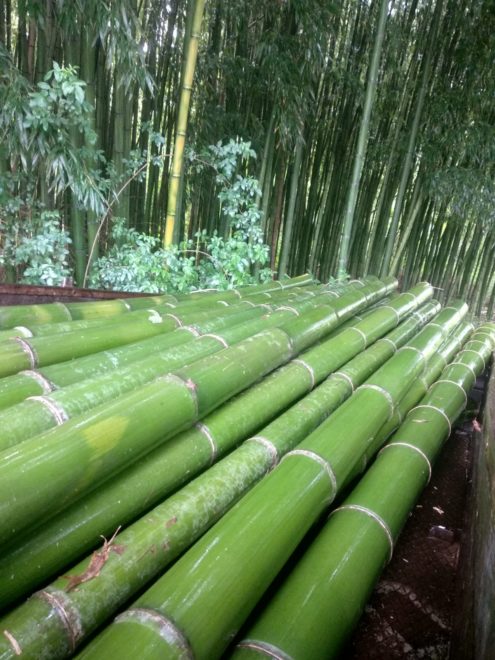
Bamboo poles grown in Portugal
Peatland conservation
Although peatlands make up just 3% of the Earth’s surface area, they store twice as much carbon as all the world’s forests combined, which cover 30% of the globe. This makes them one of the most important natural carbon vaults, and maintaining healthy peatlands is an extremely valuable asset when it comes to tackling the climate crisis.
However, if drained or burned, peat has the opposite effect, releasing all the carbon that it has stored into the atmosphere. It is estimated that the emissions produced by draining or burning peatlands currently make up 5% of global Greenhouse gas emissions – in the range of two billion tonnes CO2 per year.
The Global Peatlands Initiative is an effort by leading experts and institutions to save peatlands as the world’s largest terrestrial organic carbon stock and to prevent it being emitted into the atmosphere.
Blue Carbon Management
Blue carbon is the carbon stored in coastal and marine ecosystems. The Blue Carbon Initiative has estimated that more than 80% of the global carbon cycle takes place in the ocean, and although coastal ecosystems like mangroves, tidal marshes and seagrasses only occupy 2% of the total ocean area, they are major contributors to organic carbon burial. They accumulate organic rich soils that can often extend to many metres depth and provide long-term storage of organic carbon.
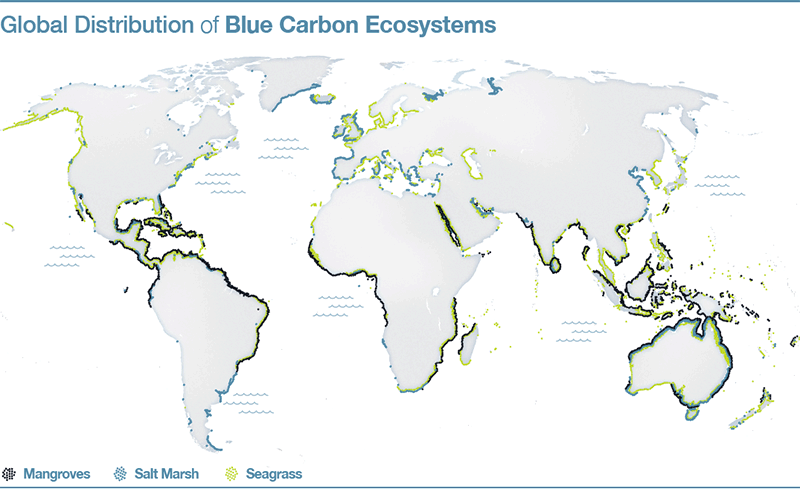
In the open seas, small crustacean (Copepod) eat phytoplankton, and produce carbon through digestion. A proportion sinks to the bottom of the oceans, and estimates are that this could be as much as 3-4 Gt Carbon per year. Marine protection to stop further depletion of these creatures will help to slow the speed of climate change.
Another surprising aspect of blue carbon is the carbon capture potential of whales. Whales accumulate carbon in their bodies during their long lives. When they die, they sink to the bottom of the ocean, and it is reported that each great whale carcass contains the equivalent of 33 tons of CO2 on average.
Protecting whales and better management of fisheries could therefore add significantly to carbon capture because the current population of the largest great whales is only a small fraction of what it once was. After decades of industrialized whaling, biologists estimate that overall whale populations are now to less than one fourth what they once were.
Mangrove restoration
Mangrove forests grow on the shoreline of the sea in the tropics and sub-tropics. They trap sediment (which in itself may help to capture CO2), they provide a nursery home for many marine species, they are a source of livelihood for local coastal communities, and they are reported to absorb immense amounts of CO2 – arguably more than tropical rainforests – with figures reported of up to 550 tons of carbon per hectare. What is even more important is the fact that carbon in mangrove forests is stored in the soils under the tree roots.
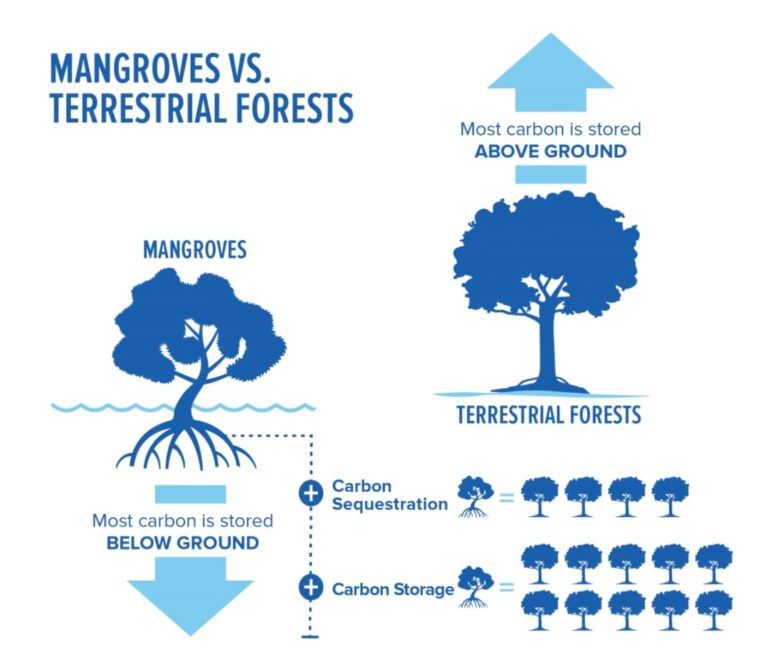
Historic rates of mangrove deforestation have created significant Greenhouse Gas emissions; since the 1950’s it has been estimated that up to 50% of the world’s mangroves have been deforested, largely due to land-use change. Halting further deforestation, and re-planting mangroves is therefore a very effective way of mitigating climate change.
Moreover, as many of the natural mangroves have been cut in the last decades, and often transformed into fish ponds or marginal agriculture, re-planting mangroves would create an additional carbon sink, and carbon credits could be provided for those mangrove restoration activities that are carried out to help reduce carbon emissions.
The Global Mangrove Alliance brings together technical experts, civil society organizations, governments, local communities, businesses, funding agencies and foundations to accelerate a comprehensive, coordinated, global approach to mangrove conservation and restoration at a scale that matters.
Sea Grass Restoration
Seagrasses don’t receive much attention as they are under water, but they are one of the most productive ecosystem types on the Earth. Seagrasses are found in shallow salt water around the world, from the tropics to the arctic. They form dense underwater meadows that provide shelter and food to a hugely diverse community of creatures, from tiny invertebrates to fish, turtles, dugongs, endangered seahorses, crabs and even birds. Some of these meadows are so vast, they can be seen from space.
They also have an incredible ability that helps fight climate change – a huge capacity for carbon absorption. Seagrasses act as a dense sediment trap, capturing carbon and storing it, eventually depositing it onto the seafloor. Seagrass can capture carbon from the atmosphere up to 35 times faster than tropical rainforests and, even though it only covers 0.2% of the seafloor, it absorbs 10% of the ocean’s carbon each year, making it an incredible tool in the fight against climate change.
Protecting and restoring seagrass beds is another example of nature-based solutions for climate change mitigation. Project Seagrass is a UK-registered marine conservation charity dedicated to ensuring that seagrass meadows are protected globally, for the biodiversity and people that depend on them.
NBS for Energy
Energy generated from fossil fuels is one of the most important sources of greenhouse gas emissions. The introduction of alternative, renewable energy is therefore an important mitigating factor. Wind turbines and solar panels use the availability of wind and sunshine to generate energy, and the use of these new sources of energy is growing.
Using natural resources like wood pellets is better than using coal, oil or gas but it does require the harvesting of natural resources, and it produces CO2. Biofuels using food crops are questionable as burning food is not a good idea, but using agricultural or household waste is a positive way of creating biofuel. The volumes of local biofuel production may be small, but can be used for household or local area power generation.
Yet, one of the current developments is the industrial production of Sustainable Aviation Fuel (SAF) from waste. This is considered one of the easiest answers to the environmental impact of flying, and nearly 400,000 commercial flights have already been partially powered by SAF. SAF can be blended with conventional fuel and therefore require no changes to aircraft or airport infrastructure.
SAF are manufactured from municipal waste, agricultural residues and waste lipids. They are only approved as true SAF if the feedstocks and technologies do not threaten food security, result in direct or indirect land use change, or have significant emissions footprints.
Hydropower has been an aspect of energy provision for a much longer period of time, and many of the large rivers of the world have dams to generate electricity. The World Commission on Dams analysed river management around the world in the nineties of the last century, and came to the conclusion that many dams were planned without proper socio-economical and environmental considerations. Moreover, many of the dams that were constructed more than half a century ago now show signs of decay and may need to be removed to avoid collapse. There is a growing movement to decommission old dams, and to restore river flows, as this example in Estonia shows
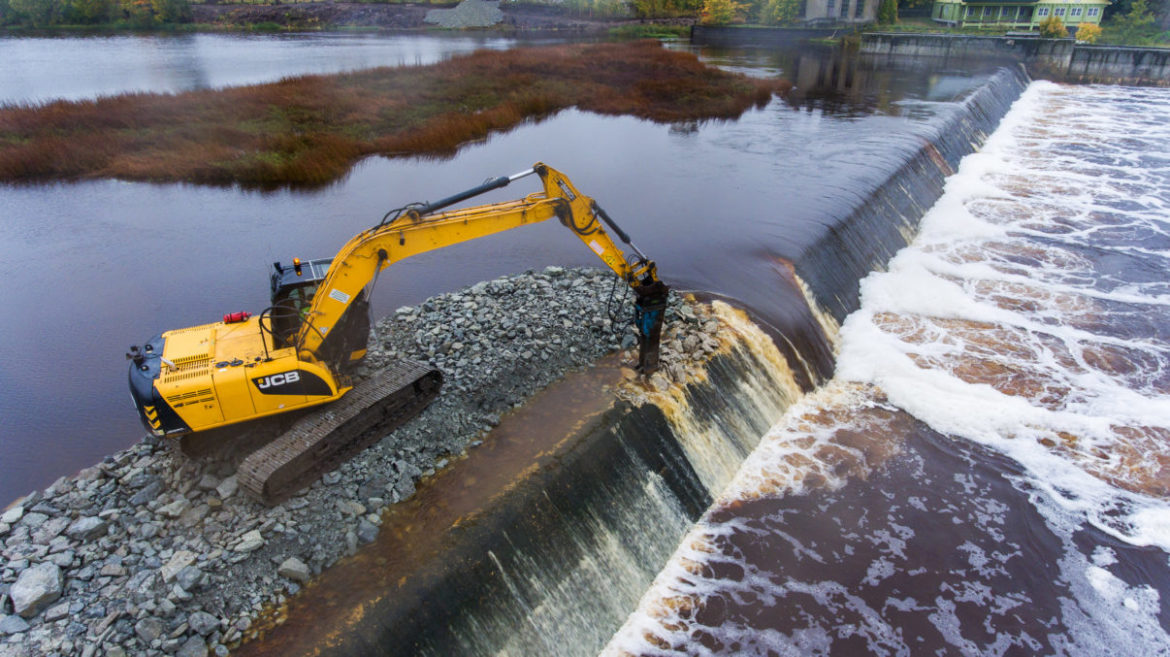
Removal of Sindi dam on Pärnu River. photo by Ministry of the Environment of Estonia
Working with rivers to construct environmentally sound hydropower sources, especially of a smaller scale than the mega dams that were in vogue some decades ago, could create sustainable power sources for local communities that are not harmful to the aquatic biodiversity and maintain the critical ecosystem services of the river basins.
Another area of renewable, sustainable energy that has not been explored is the opportunity to harness the power of the sea. Wave energy, energy from submarine flows and energy from tides are all areas of Research and Development, but could become significant nature-based renewable energy solutions.
NBS for carbon reduction in an urban context
Afforestation and reforestation are landscape management approaches in the rural areas, but in cities we have other opportunities. Greening cities will help to regulate temperatures, provide space for recreation and create opportunities for local biodiversity.
Green roofs will help with building insulation and provide opportunities for biodiversity support. They will also help with absorption of greenhouse gases, and they can be an effective tool in reducing the carbon footprint of an urban area.
Re-thinking urban planning and development by including more green spaces, creating pedestrian use zones, promoting bicycle use and reducing the areas allocated for vehicles will help to reduce the emissions from urban areas.
Moreover, re-fitting buildings with better insulation, photovoltaic windows, larger roof overhangs to create shade and options for natural ventilation will drastically reduce the carbon footprint of residential areas. Using wood and bamboo where possible will help to reduce the impact even more.
NBS for methane reduction
Methane (CH4) is the second most abundant emitted Greenhouse Gas after carbon dioxide (CO2), accounting for about 20 percent of global emissions. Methane is more than 25 times as potent as carbon dioxide at trapping heat in the atmosphere, and as this graph illustrates, in 2017, half of the methane emissions in California were a result of agricultural production and waste management.
The impact of cattle farming has recently been highlighted as a major source of methane production. This is an issue that is a key consideration in the case of intensive cattle rearing, like the example in Brazil below.
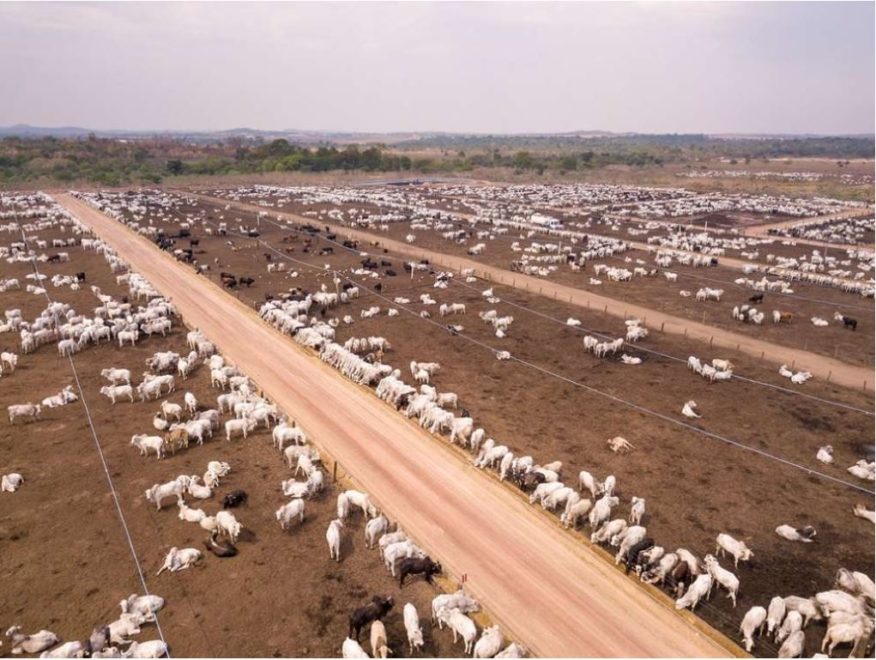
Cattle farming in Brazil.
Photo from innovationnewsnetwork.com
Moreover, the current cattle ranches in this part of the world often were originally forest land, and the clearing of the forest has been an additional source of carbon dioxide and methane. Therefore, a change in diet to promote low-beef consumption, and the resulting reduction of large-scale cattle ranching would make a significant impact on methane production. Small-scale livestock farming will have little or no effect on the overall global greenhouse gas balance, so there is no need to stop rearing of individual cows, sheep or goats.
Methane is also produced by the breakdown or decay of organic material and large volumes of methane are trapped in peat soils, coastal and freshwater wetlands, and the artic permafrost. Wetlands and peatlands are actively drained for agricultural production and urban developments, and the International Convention of Wetlands estimates that 35% of the world’s wetlands have been lost since 1970, but half of the wetlands that existed in 1900 are now drained. The continued destruction of these critical ecosystems will therefore produce significant amounts of methane, as well as carbon dioxide. Better protection of remaining wetlands and peatlands would therefore reduce additional emissions of methane, and this would have a real impact on climate change.
Scientists have found that permafrost buried beneath the Arctic Ocean holds 60 billion tons of methane and 560 billion tons of organic carbon — making it a major source of greenhouse gases not currently included in climate projections that could have a significant impact on climate change in the longer-term. Regrettably, there is little we can do to stop the melting of permafrost, apart from stopping climate change as a whole.
Conclusion
Working with nature will not stop climate change, but it will help to alleviate the hardships of many people, and it is one of the most effective and efficient ways to absorb current greenhouse gases in the air and reduce further emissions.

Let s plant , every where we can. Cristo. Bambooman la reunion island